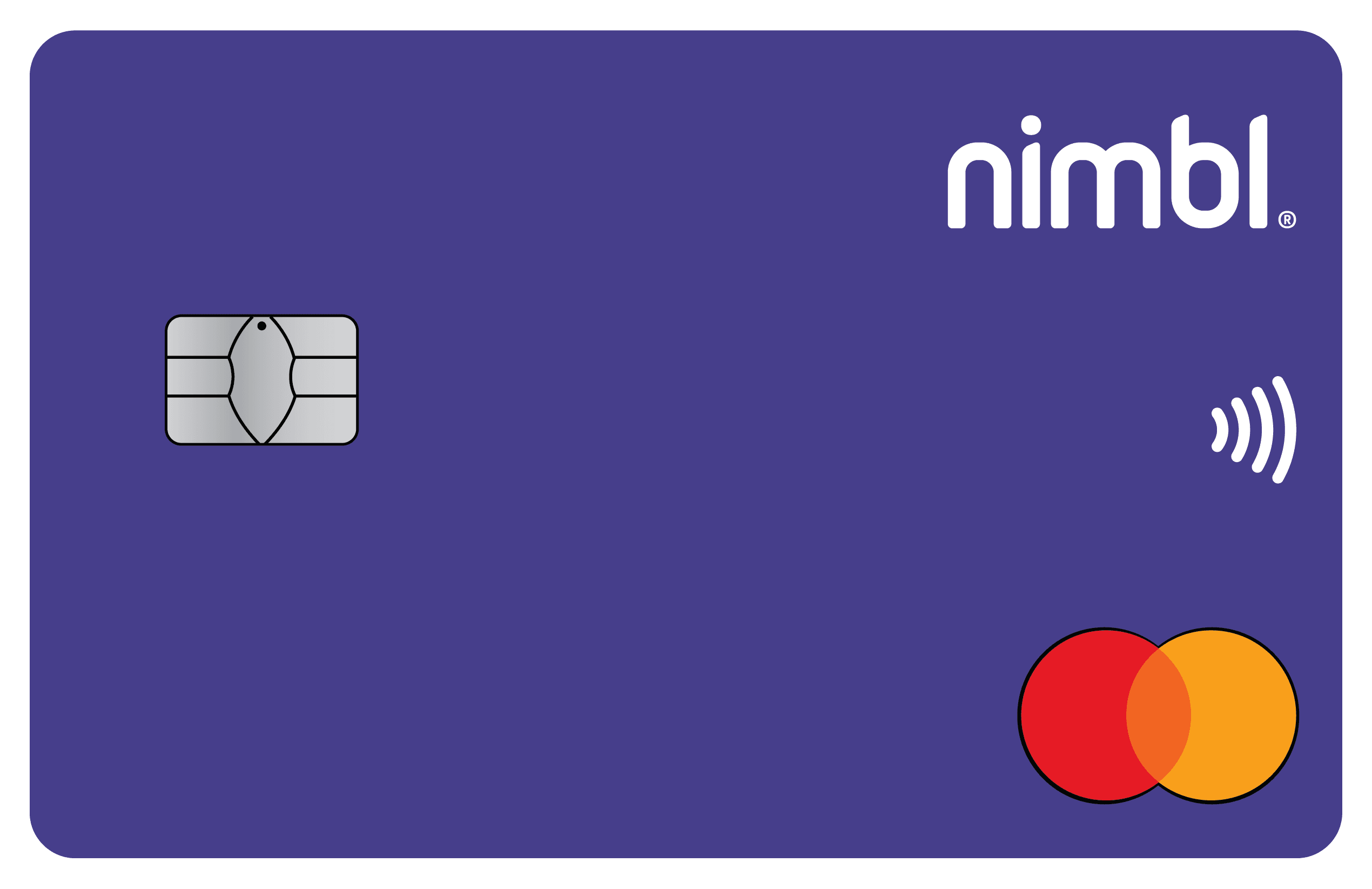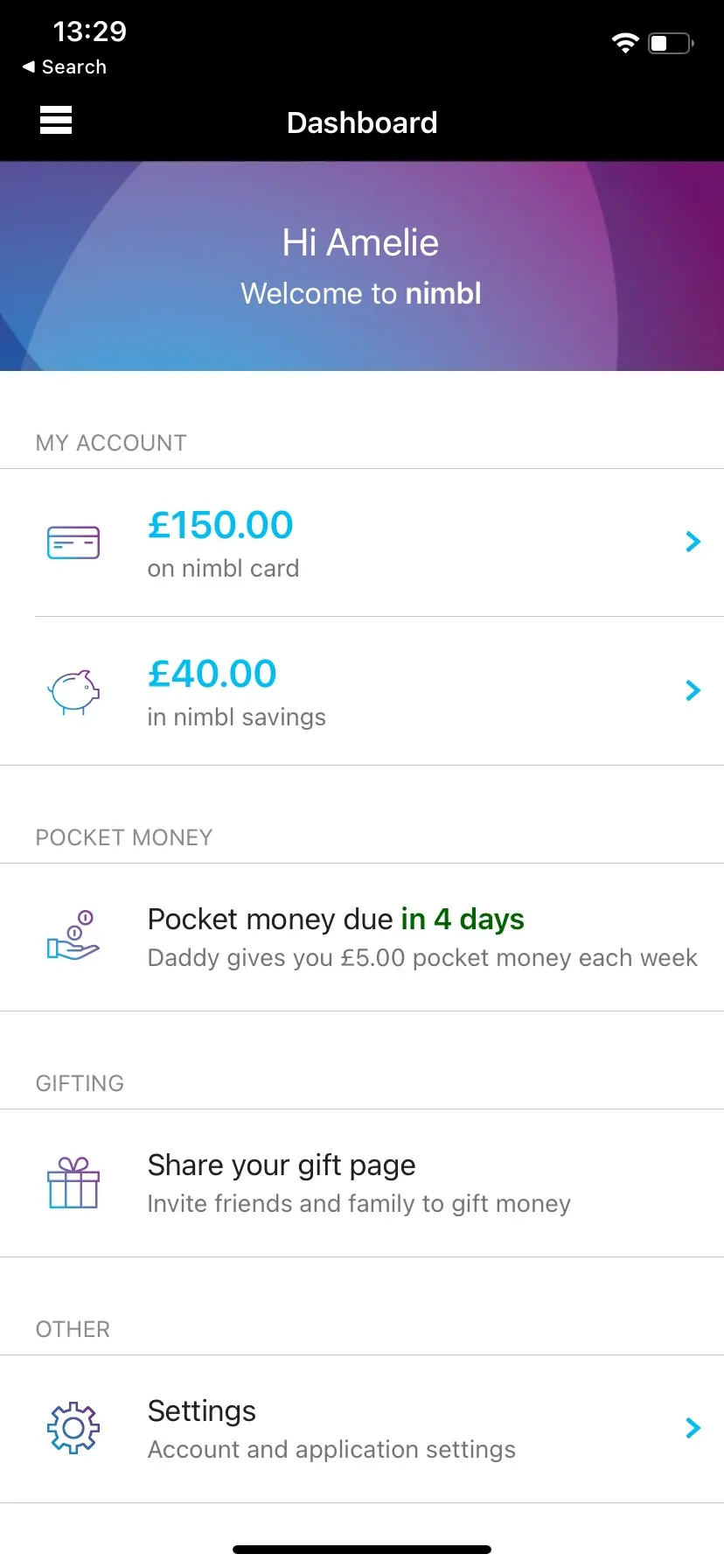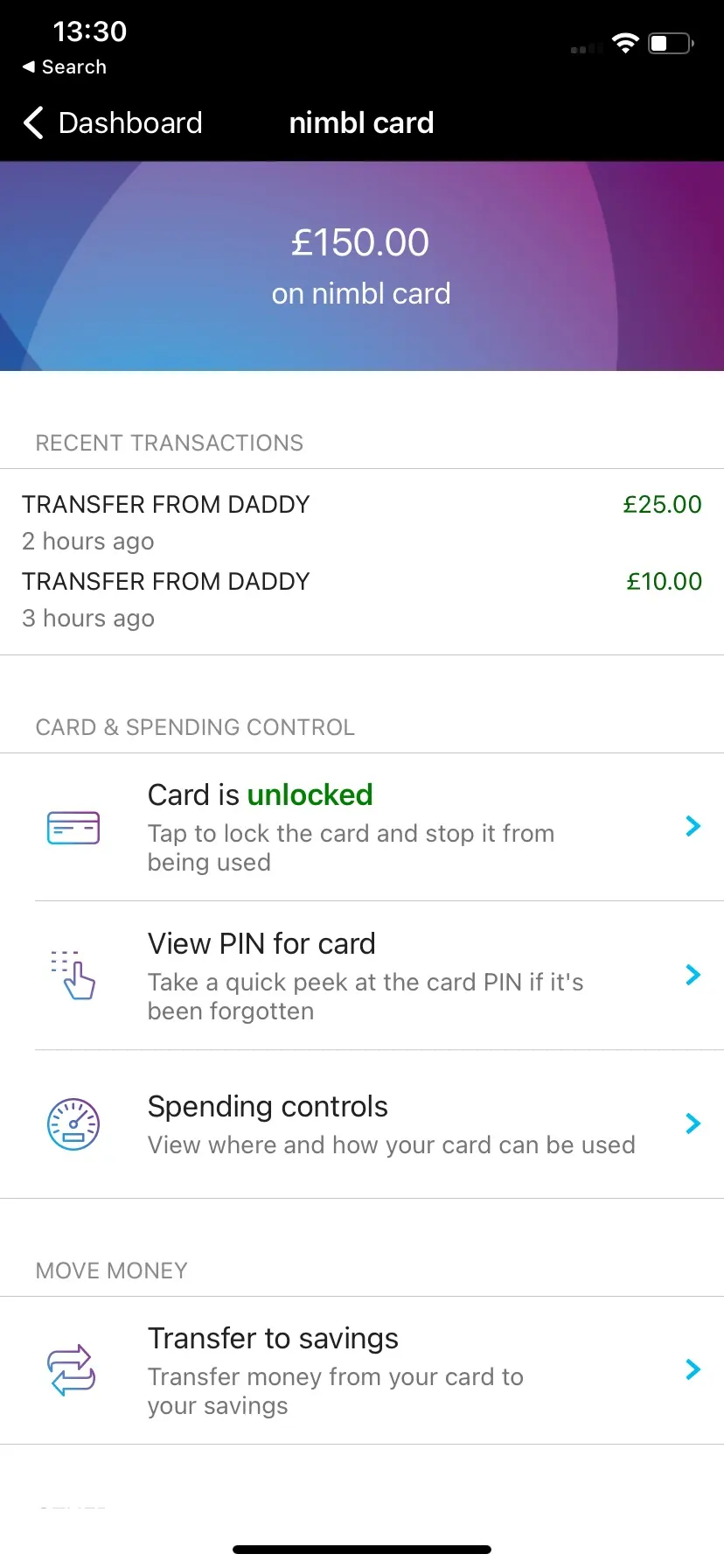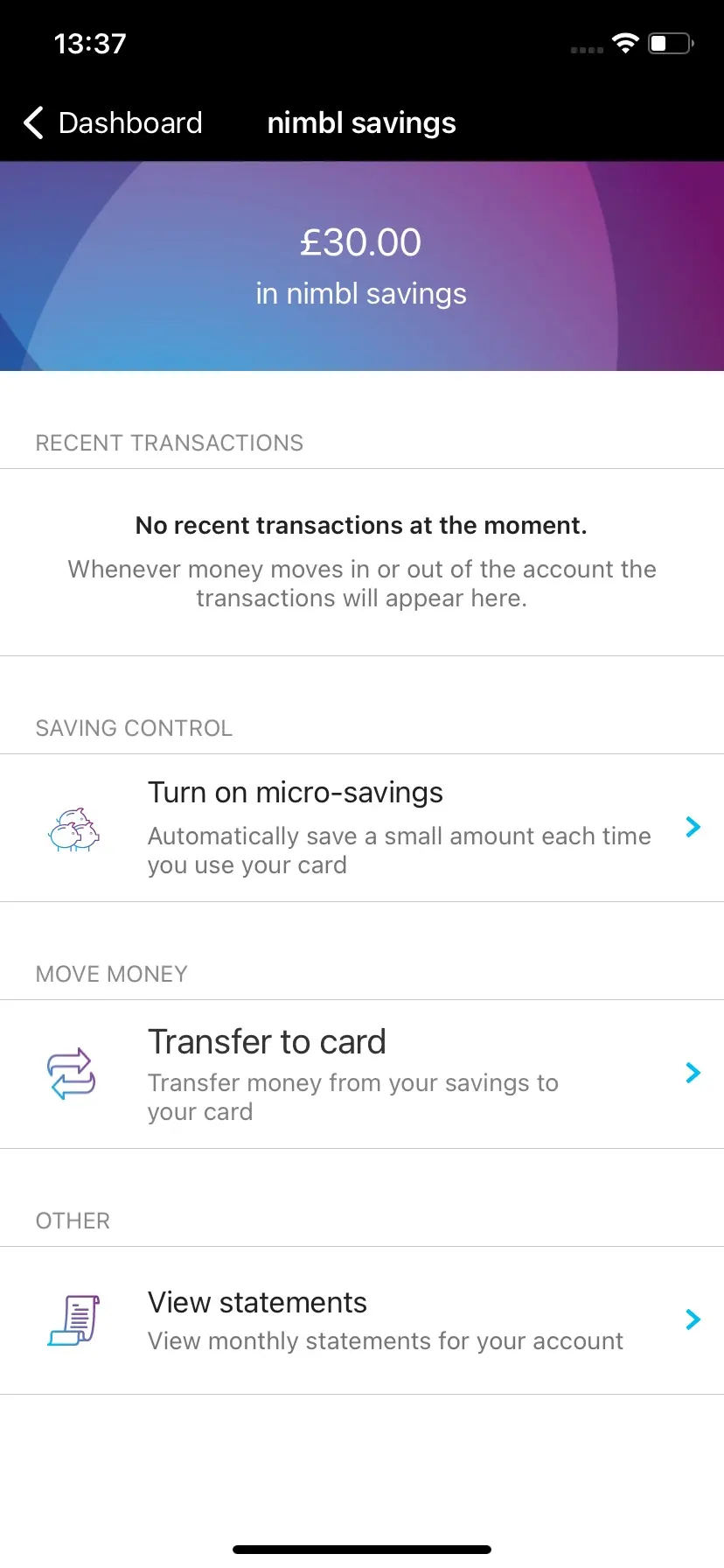nimbl review

- Key benefits
- Get 6 months free when you sign up via Finder - that's £1.33 per month for the first child. T&C's apply.
Our verdict
nimbl's card and app suits young kids well, and it has a unique feature to get them into the savings habit.
We picked nimbl as the best kids' debit card for regular saving because it's the only one with a micro-savings feature, which works like a round-up function. Kids can automatically save between 5p and £5 every time they spend on their card. They can use nimbl from age 6, meaning they can learn how to use a budgeting app from a very young age. Your child will feel like a grown-up with a fancy card and a certain degree of autonomy, but at the same time you won't actually be handing over any of the control and you'll always know what they are using the money for.
It can also work fine for teenagers - parents can turn off the spending notifications they get on their phone to allow them some privacy. However, at that point it may not be worth the monthly fee - you'll save money with a regular children's account from a traditional bank. But if you'd rather keep a very close eye on their finances instead, nimbl is probably one of the best products available.
Get started by visiting nimbl's website and ordering a card. If you have read this review and decided that nimbl's card is not for you, you can also discover other prepaid cards for kids on the market.
nimbl is one of a growing number of prepaid card and app combinations aimed at children and their parents. Our guide on this topic explains how prepaid cards differ from the debit card that comes with a traditional children's bank account.
Pros
-
Full control on how children spend their money thanks to spending control settings and instant notifications.
-
Children as young as six years old can use it.
-
It helps you to educate your children to manage their finances.
-
You can turn off online payments or cash withdrawals.
-
Safe and secure. The card can be blocked online or via the app.
-
You can manage more than one Child Account from the same Parent Account.
-
No fees for topping up the Parent Account or child’s card, or for “Gifting”.
Cons
-
While most mainstream bank accounts for children are for free, nimbl charges a monthly fee.
-
You cannot top up the account using cash.
-
With nimbl, children earn no interest on any savings.
nimbl is a prepaid card that comes with an intuitive app and a series of useful features for parents and children. It isn’t a bank and doesn’t offer a regular current account, but it can help give your child a sense of responsibility when it comes to money.
What is nimbl?
nimbl offers a prepaid debit card for kids coupled with a smartphone app. The app comes with useful features for both parents and children, such as digital pocket money, instant top ups, parental controls, a gifting function and a savings tool.
Essentially, nimbl allows parents to put money on their children’s spending card, either through occasional top ups or by setting up regular payments (the digital pocket money). Children can then use the funds as they wish, be it buying ice creams every week or saving for an expensive video game console.
The idea is to promote good money habits for 6–18 year olds, training children to save, budget and be organised with their money. nimbl has been featured in our best debit cards for kids guide.
How does nimbl work?
nimbl comes with 2 accounts: one for the parents (Parent Account) and one for the children (Child Account).
The spending card is linked to the Child Account, so adults cannot use nimbl to purchase items directly. Through the Parent Account they can top up the Child Account, while through the app they can check how the money is being spent. They will receive real-time notifications every time the child buys something with the card, and they can also set up daily or monthly spending limits, as well as set up spending blocks.
The child’s card can be used to purchase items in physical stores, online and to withdraw cash at ATMs. It also has a contactless feature.
If you have a larger family, nimbl allows up to 4 Child Accounts (and 4 cards) for every Parent Account.
What are nimbl’s features?
nimbl is made up of two parts: the card (specifically for children) and the app (designed for both parents and children to use).
The app’s features include:
- Digital pocket money. Parents can set up and automate weekly or monthly pocket money.
- Instant top ups. Parents can transfer money to their children’s cards instantly, whether they are out at the local shops or travelling somewhere overseas.
- Micro-savings. Children can choose to automatically save between 5p and £5 every time they use their nimbl card.
- Statements. Parents can use the app to see where their children are spending money.
- Spending controls. Parents can decide where and when their children’s nimbl cards can be used, with limits available to set on cash machines, online and in-store spending.
- Spending alerts. Parents can be instantly notified every time their children use their cards, including the amount spent and where.
- Gifting. With the “Gifting” function, family and friends can transfer money directly to a child’s nimbl card via a web link, if they’d like to send some pocket money or a birthday gift, for example.
- Tasks. Parents can add tasks for children to do and pick a payment value. Once the task is completed, they can tick it off and the money will be transfered to the child.
What types of purchase can I block with nimbl?
You can block online purchases and you can also turn off ATM withdrawals if you don’t want your children to hide any purchases by using cash.
nimbl says it automatically blocks transactions from some age-inappropriate retailers, such as gambling websites, casinos, off-licences, pubs and adult content, but it is ultimately your responsibility to ensure that the card is not used for purchases that require the consumer to be at least 18 years old. nimbl will not, for instance, refuse a transaction from a grocery store, even if an age-inappropriate product is being bought.
How do I apply?
Children cannot apply for a nimbl card by themselves, parents have to do it on their behalf. You need to be at least 18, living in the UK and the legal guardian of the minor you’re setting up the account for.
Your child must be living at the same address as you and be at least 6 years old.
The online application process sometimes requires you to provide proof of identity and proof of address – if you can’t, your application will either be refused or you will be granted a restricted account with lower spending limits.
Once the application has gone through, nimbl will post the child’s card to your home address for free. Once you get the card, you will have to activate it online and download the app. All in all, nimbl says it usually takes 7–10 working days to complete the application process and get the card.
Is nimbl safe?
nimbl is not a bank, so customer funds are not covered by the Financial Services Compensation Scheme (FSCS), which protects individual deposits of up to £85,000. But nimbl is fully regulated by the Financial Conduct Authority (FCA) and is licensed to issue electronic money.
The prepaid card is a Mastercard and is protected by a PIN. If it gets misplaced, the child or parent can temporarily lock it through the app (and unlock it again if the card turns up). If the card is permanently lost or stolen you’ll have to report it to nimbl’s customer service and order a replacement, priced at £5.
How much does nimbl cost?
nimbl costs £32 a year for the first card, which includes use of the app. Additional cards cost £27 a year. Card purchases, top ups and UK ATM withdrawals are all free.
If your child uses the card abroad, be aware that there is a 2.95% fee (Cash withdrawal fee £1.50).
What does the nimbl app look like?



nimbl’s fees and features
 nimbl Account | |
| Monthly fee | £32 |
| Card delivery fee | £0 |
| UK card transaction fee | £0 |
| UK cash withdrawal fee | £0 |
| Loading fee | £0 |
| Replacement card fee | £5 |
| Network | Mastercard |
| Account type | debit |
| How many child accounts | 4 |
| Other fees | £0 |
| Freeze/unfreeze card |
nimbl’s customer reviews
In our 2025 customer satisfaction survey 70% of nimbl’s customers we surveyed said they’d recommend the service.
Customers praised the product’s quality and said it was “safe and easy to use”.
Another customer said: “It helps my kids to spend money.”
The app has a rating of 4.7 out of 5 from around 3,300 reviews on the App Store. On Google Play, the app has a score of 4 out of 5 from over 1,200 Android app users (updated March 2025).
Customer service information for nimbl
| Email support | |
|---|---|
| Telephone support | |
| In-app or live chat | |
| Contact form | |
| Branch support |
Frequently asked questions
All user-submitted reviews must meet our review guidelines. These set out our standards and expectations, including that the review is from by a genuine user of the relevant product or service and that it is honest, authentic and respectful. We explicitly prohibit fake or otherwise misleading reviews and we check all submissions, but we make no guarantee as to the authenticity of any published review or reviewer. Some reviews may be submitted (regardless of sentiment) in exchange for entry into any competition(s) for which we are the promoter.

